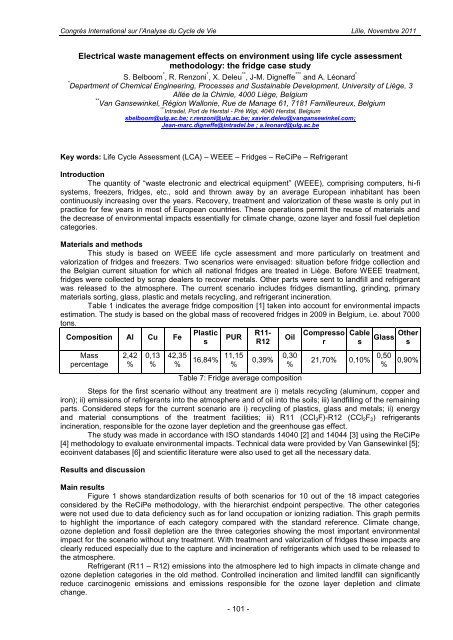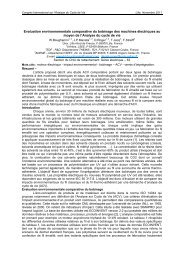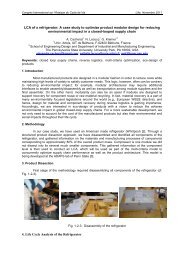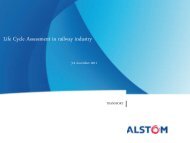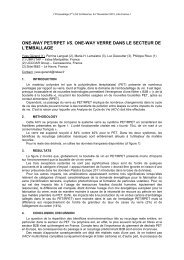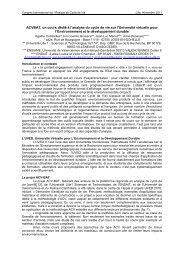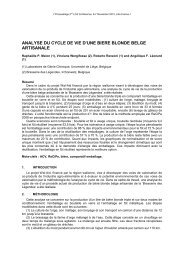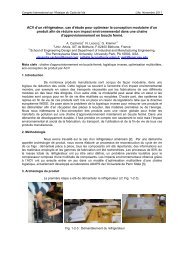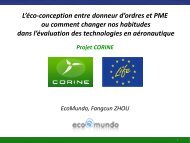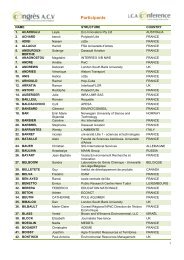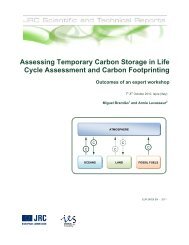Untitled - avniR
Untitled - avniR
Untitled - avniR
Create successful ePaper yourself
Turn your PDF publications into a flip-book with our unique Google optimized e-Paper software.
Congrès International sur l’Analyse du Cycle de Vie Lille, Novembre 2011<br />
Electrical waste management effects on environment using life cycle assessment<br />
methodology: the fridge case study<br />
S. Belboom * , R. Renzoni * , X. Deleu ** , J-M. Digneffe *** and A. Léonard *<br />
* Department of Chemical Engineering, Processes and Sustainable Development, University of Liège, 3<br />
Allée de la Chimie, 4000 Liège, Belgium<br />
** Van Gansewinkel, Région Wallonie, Rue de Manage 61, 7181 Familleureux, Belgium<br />
*** Intradel, Port de Herstal - Pré Wigi, 4040 Herstal, Belgium<br />
sbelboom@ulg.ac.be; r.renzoni@ulg.ac.be; xavier.deleu@vangansewinkel.com;<br />
Jean-marc.digneffe@intradel.be ; a.leonard@ulg.ac.be<br />
Key words: Life Cycle Assessment (LCA) – WEEE – Fridges – ReCiPe – Refrigerant<br />
Introduction<br />
The quantity of “waste electronic and electrical equipment” (WEEE), comprising computers, hi-fi<br />
systems, freezers, fridges, etc., sold and thrown away by an average European inhabitant has been<br />
continuously increasing over the years. Recovery, treatment and valorization of these waste is only put in<br />
practice for few years in most of European countries. These operations permit the reuse of materials and<br />
the decrease of environmental impacts essentially for climate change, ozone layer and fossil fuel depletion<br />
categories.<br />
Materials and methods<br />
This study is based on WEEE life cycle assessment and more particularly on treatment and<br />
valorization of fridges and freezers. Two scenarios were envisaged: situation before fridge collection and<br />
the Belgian current situation for which all national fridges are treated in Liège. Before WEEE treatment,<br />
fridges were collected by scrap dealers to recover metals. Other parts were sent to landfill and refrigerant<br />
was released to the atmosphere. The current scenario includes fridges dismantling, grinding, primary<br />
materials sorting, glass, plastic and metals recycling, and refrigerant incineration.<br />
Table 1 indicates the average fridge composition [1] taken into account for environmental impacts<br />
estimation. The study is based on the global mass of recovered fridges in 2009 in Belgium, i.e. about 7000<br />
tons.<br />
Composition Al Cu Fe<br />
Mass<br />
percentage<br />
2,42<br />
%<br />
0,13<br />
%<br />
42,35<br />
%<br />
Plastic<br />
s<br />
PUR<br />
16,84% 11,15<br />
%<br />
- 101 -<br />
R11-<br />
R12<br />
0,39%<br />
Oil<br />
0,30<br />
%<br />
Table 7: Fridge average composition<br />
Compresso<br />
r<br />
Cable<br />
s<br />
21,70% 0,10% 0,50<br />
%<br />
Glass Other<br />
s<br />
0,90%<br />
Steps for the first scenario without any treatment are i) metals recycling (aluminum, copper and<br />
iron); ii) emissions of refrigerants into the atmosphere and of oil into the soils; iii) landfilling of the remaining<br />
parts. Considered steps for the current scenario are i) recycling of plastics, glass and metals; ii) energy<br />
and material consumptions of the treatment facilities; iii) R11 (CCl 3 F)-R12 (CCl 2 F 2 ) refrigerants<br />
incineration, responsible for the ozone layer depletion and the greenhouse gas effect.<br />
The study was made in accordance with ISO standards 14040 [2] and 14044 [3] using the ReCiPe<br />
[4] methodology to evaluate environmental impacts. Technical data were provided by Van Gansewinkel [5];<br />
ecoinvent databases [6] and scientific literature were also used to get all the necessary data.<br />
Results and discussion<br />
Main results<br />
Figure 1 shows standardization results of both scenarios for 10 out of the 18 impact categories<br />
considered by the ReCiPe methodology, with the hierarchist endpoint perspective. The other categories<br />
were not used due to data deficiency such as for land occupation or ionizing radiation. This graph permits<br />
to highlight the importance of each category compared with the standard reference. Climate change,<br />
ozone depletion and fossil depletion are the three categories showing the most important environmental<br />
impact for the scenario without any treatment. With treatment and valorization of fridges these impacts are<br />
clearly reduced especially due to the capture and incineration of refrigerants which used to be released to<br />
the atmosphere.<br />
Refrigerant (R11 – R12) emissions into the atmosphere led to high impacts in climate change and<br />
ozone depletion categories in the old method. Controlled incineration and limited landfill can significantly<br />
reduce carcinogenic emissions and emissions responsible for the ozone layer depletion and climate<br />
change.


